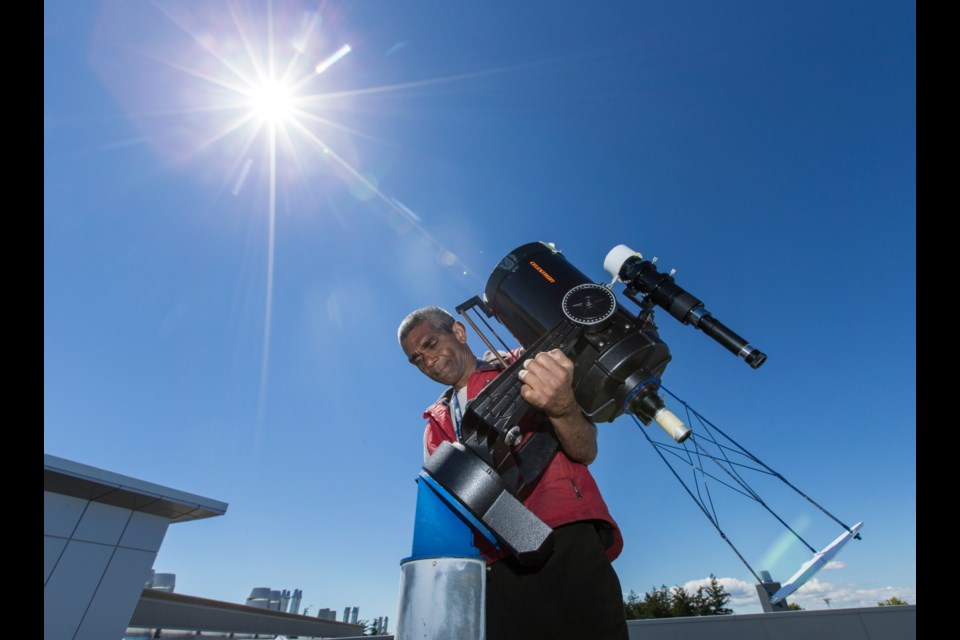Victoria’s Karun Thanjavur will be hitting the road to get the best view of the total solar eclipse coming to North American skies on Aug. 21.
He and a group of friends plan to camp out on Mount Jefferson in southern Oregon, near Bend, said Thanjavur, a senior astronomy lab instructor at the University of Victoria. It is close to where the eclipse will first be visible on the continent, and a prime viewing point within the “path of totality” — the area where the moon will completely block the sun.
The path of totality for this eclipse is a swath about 113 kilometres wide that extends diagonally across the United States from west to east. Victoria viewers will see about 90 per cent coverage from the eclipse, leaving just a narrow crescent of the sun uncovered.
“Ten per cent of light is still very bright,” Thanjavur said. “Just from looking around you, people may not notice a big dimming.”
National Research Council astronomer Ken Tapping said Thanjavur stands to be part of a large influx of Canadians heading to Oregon, including some from the NRC. Several members of the Victoria chapter of the Royal Astronomy Society of Canada will also be there.
“I gather that every hotel along the path of totality is really, really heavily booked,” Tapping said.
Thanjavur said a solar eclipse happens when the moon is aligned between the Earth and the sun, casting the moon’s shadow onto the Earth’s surface. A total eclipse is quite a spectacle, he said.
“It is very remarkable, just to see the sun completely blocked out.”
Not only does the sky darken, but the temperature drops, something Thanjavur experienced during his first total solar eclipse in Africa in 2001. “Definitely, it feels very much like dusk for a brief period,” he said.
Tapping said that while total solar eclipses happen almost annually around the world, it can be years between occurrences in any given area. The next one visible in the Victoria area is due to happen on April 8, 2024.
Eclipses are “incredible things,” Tapping said. “Even if you don’t see totality, it is really, really magical.”
A range of sites will be good for local viewing, said Jonathan Geehan, who has a master’s degree in astronomy and will help lead a new astronomy course at Victoria High School.
“Really, anywhere that you can see the sun in the sky on the morning of Aug. 21 will work.”
He said the eclipse starts at 9:08 a.m. and ends at 11:37 a.m., with this area’s maximum partial eclipse coming at 10:20 a.m.
Thanjavur said interest in the eclipse is evident at UVic’s weekly astronomy open houses. “I can definitely sense an excitement in astronomy in the general public.”
All three men stressed the need to use special solar viewers or to take other safety measures when looking at the eclipse — sunglasses are not sufficient.
Proper glasses will be given out at the eclipse-viewing event at UVic’s Bob Wright Building at 10 a.m.
Filtered telescopes that provide safe viewing will also be available.
“The problem, basically, is the sun is dangerous to stare at, period,” Tapping said. “Without proper eye protection, with the emphasis on the word ‘proper,’ you shouldn’t stare at it during an eclipse.”
Looking at the eclipse without harming your eyes
It’s not safe to look directly at the sun. Even looking at a small part of it or looking for a short period of time can cause permanent damage to the retina.
NASA offers the following tips:
• The only safe way to look directly at the uneclipsed or partially eclipsed sun (as will be visible in Victoria) is through special “eclipse glasses” or hand-held solar viewers.
• Homemade filters or ordinary sunglasses, even very dark ones, are not safe for looking at the sun.
• Five manufacturers have certified that their eclipse glasses and handheld solar viewers meet the international standard for such products: American Paper Optics, Baader Planetarium (AstroSolar Silver/Gold film only), Rainbow Symphony, Thousand Oaks Optical and TSE 17.
• Do not look at the uneclipsed or partially eclipsed sun through an unfiltered camera, telescope, binoculars or other optical device. Similarly, do not look at the sun through a camera, a telescope, binoculars or any other optical device while using eclipse glasses or hand-held solar viewers.
For more information:
• NASA — eclipse2017.nasa.gov
• Royal Astronomical Society of Canada — rasc.ca/solar-eclipse-2017



